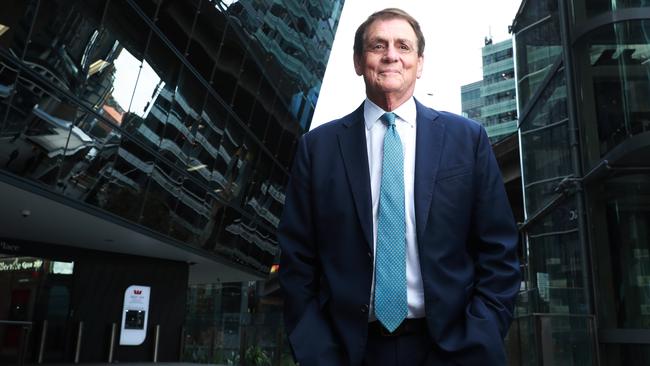Economists revise their forecasts as RBA slows rates
Market pricing of more rate rises has shrunk to about 15 basis points but Westpac’s Bill Evans says there has been a ‘somewhat confusing’ signal from the RBA’s assessment of inflation.

The Reserve Bank has further slowed the pace of interest rate rises as it predicts that Australia’s inflation rate will be “back within the 2-3 per cent target range” by the end of 2025.
Tuesday’s decision to leave the cash rate unchanged at a decade high of 4.1 per cent marked the first two-month pause since the RBA started lifting rates from 0.1 per cent in May last year.
While a lift was only priced as a 25 per cent chance by the money market, the decision surprised a majority of economists who had expected a 25-basis-point rise in the cash rate to 4.35 per cent.
Expectations of a rise were based on persistently high services inflation, a tight labour market, upward pressure on wages and the RBA’s guidance that some further tightening of monetary policy may be required to ensure that inflation returns to target in a reasonable time frame, which was repeated on Tuesday.
Market pricing of more rate rises subsequently shrank to about 15 basis points. Many economists lowered their forecasts for the peak cash rate and some said rate rises probably ended in June. The dollar fell almost 1 per cent to US66.43c after the decision as 10 and three-year Australian government bond yields fell seven and 11 basis points, respectively, as the yield curve “bull steepened”.
The sharemarket reacted positively, with the S&P/ASX 200 index rising 0.5 per cent to 7450.7 points, near its highest levels since February. However, most economists continue to predict at least one more rate rise and no cuts until the second or third quarters of 2024 as a shallower rate rise cycle may lessen a nascent economic downturn.
Updated economic forecasts in Friday’s quarterly Statement on Monetary Policy should show the RBA’s forecasts are conditioned on the assumption that the cash rate follows a path broadly in line with expectations derived from surveys of economists and financial market pricing. That should imply a cash rate peak of bout 4.35 per cent, versus the assumption in the May SOMP that the cash rate would peak at about 3.75 per cent.
Apart from the new forecast that CPI inflation will fall to within the 2-3 per cent target band in late 2025, other forecasts on economic growth around 1.75 per cent in 2024 and a little over 2 per cent in 2025, and an unemployment rate rising to 4.5 per cent by late 2024 were little changed.
The RBA’s updated SOMP forecasts for the unemployment rate in 2025 will be key for the inflation outlook.

Deputy governor and soon-to-be governor Michele Bullock has nominated 4.5 per cent as the non-inflation accelerating rate of unemployment.
Westpac chief economist Bill Evans said there was a “somewhat confusing signal” from the RBA’s assessment of the recent better-than-expected inflation print for the June quarter.
The central forecast for inflation in 2024 was held at 3.25 per cent, indicating that the lower-than-expected June quarter CPI report was not interpreted as signalling a flatter inflation trajectory. On the other hand, the RBA was more confident on the outlook for inflation, with its assessment that recent data was consistent with inflation returning to the target range over the forecast horizon.
“With the current forecasts having inflation slowing from 3.2 per cent to 3 per cent in the first half of 2025 and the decision statement noting the central case economic growth forecast to be lifting from 1.75 per cent to 2 per cent – unchanged from May – it’s unlikely the fall into the range will be more than 0.2 percentage points to 2.75 per cent, indicating that the board is still comfortable to continue to see inflation holding above the middle of the target range after more than four years above the target range,” Mr Evans said.
In his statement, RBA governor Philip Lowe continued to emphasise significant uncertainties around the persistence of services inflation, introducing a potentially profound new insight, likely drawn from the experience in the US and other countries. “There are also uncertainties regarding the lags in the operation of monetary policy and how firms’ pricing decisions and wages respond to the slowing in the economy at a time when the labour market remains tight,” Dr Lowe said.
Mr Evans said this observation may be disclosing that the board was prepared to entertain the possibility that, due to weak demand, firms were unable to pass on higher costs, including wages, holding down inflation and squeezing margins. “This clearly raises questions about the nexus between tight labour markets and rising inflation, possibly explaining why the board has not responded to the signs of further tightening in labour markets over the last two meetings,” he said.
The issues of weak productivity growth, strongly rising unit labour costs, and a margin squeeze continue to get the attention of the board, with Dr Lowe saying: “At the aggregate level, wages growth is still consistent with the inflation target, provided that productivity growth picks up.”
“They can raise the issue but provide no reason why productivity growth is likely to pick up,” Mr Evans said. “The national accounts for the June quarter will print the day after the September board meeting with likely evidence that unit labour costs continue to rise at a cracking pace – the most recent update having already shown a 7.9 per cent rise over the year to March.”
Mr Evans said that in not acting in those circumstances and indicating that recent data was consistent with inflation returning to the 2-3 per cent target range over the forecast horizon, the balance of risks now favoured the prospect that the RBA was now on hold.




To join the conversation, please log in. Don't have an account? Register
Join the conversation, you are commenting as Logout